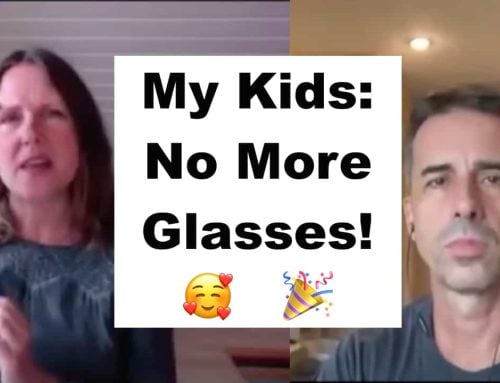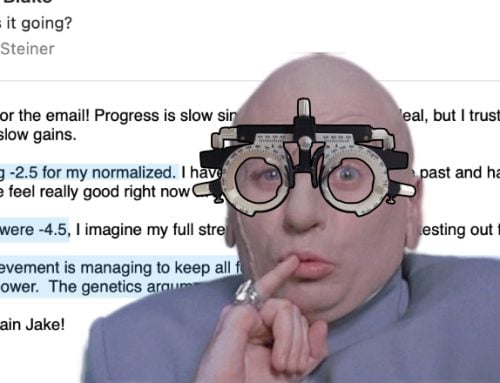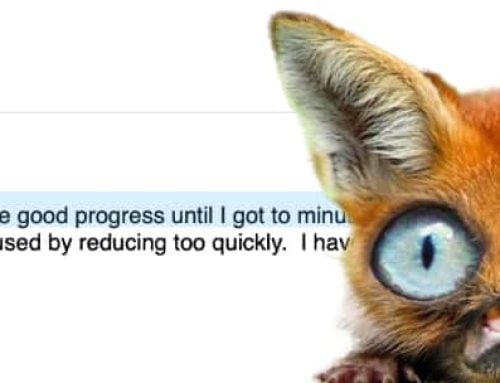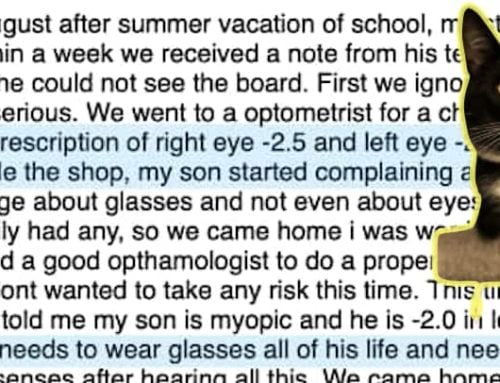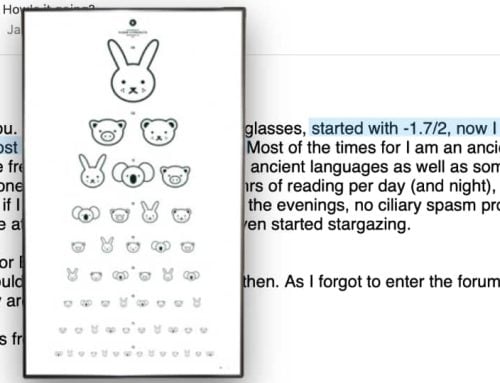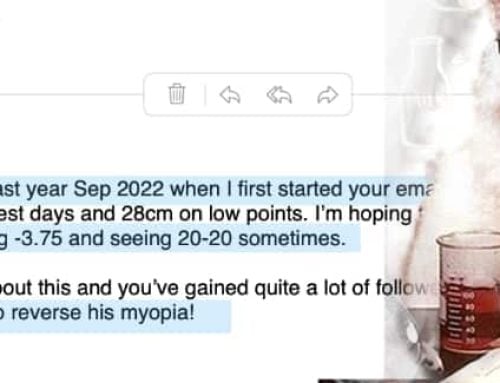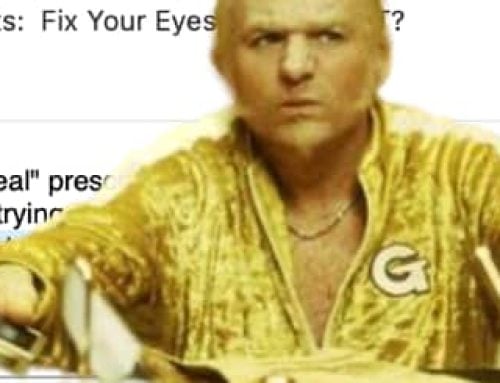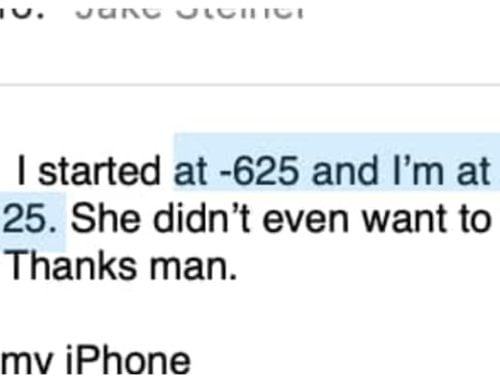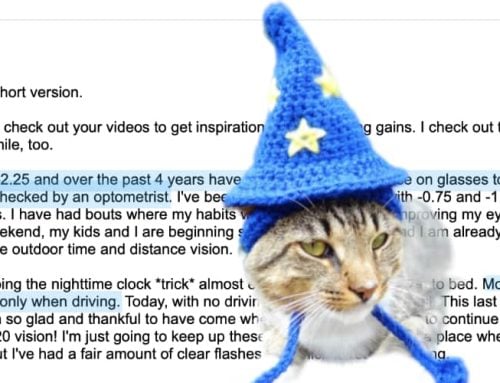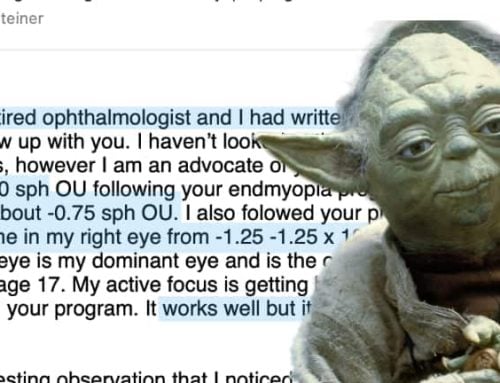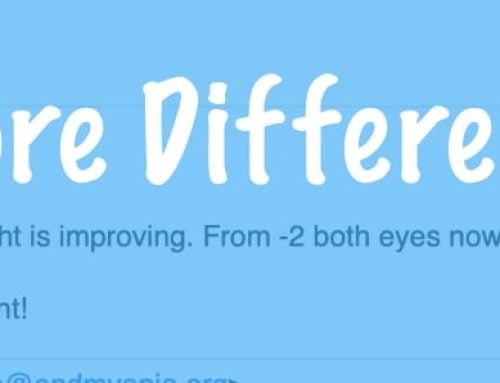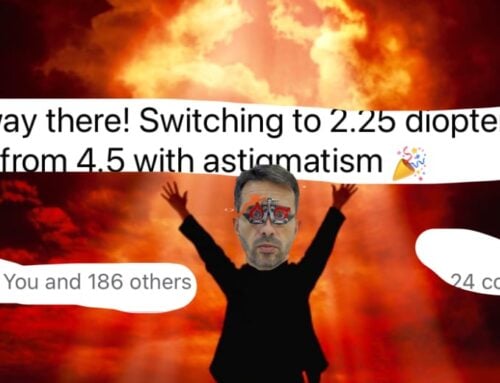Hao writes in the forum:
![]() I’ve been myopic since grade school. I started wearing glasses at 12 yo, -2.25/-2.25 at the time. Around this time last year, February 2013, I went to the optometrist and was prescribed -4.75OD/-5.25OS, with -1.00/-0.50 astigmatism corrections, respectively. I was scared that my visual acuity would keep getting worse and worse. Plus, the new glasses didn’t feel right. I thought my eyes were telling me they were too strong. So I started looking into myopia rehab and subsequently found livestrong.com blog and the #endmyopia clinic.
I’ve been myopic since grade school. I started wearing glasses at 12 yo, -2.25/-2.25 at the time. Around this time last year, February 2013, I went to the optometrist and was prescribed -4.75OD/-5.25OS, with -1.00/-0.50 astigmatism corrections, respectively. I was scared that my visual acuity would keep getting worse and worse. Plus, the new glasses didn’t feel right. I thought my eyes were telling me they were too strong. So I started looking into myopia rehab and subsequently found livestrong.com blog and the #endmyopia clinic.
I started experimenting with weaker prescriptions. I noticed very rapid improvements within the first 3 months. My incremental improvements got smaller after that. Being in medical school and having to do a ton of close-up work probably contributed to that, although in retrospect I see that I made jumps every 3-4 months. I started the Web program in December because I haven’t seen any improvements since September and thought that I might have hit a plateau. But in January I noticed another jump so I’m quite happy about that.
My current measurements:
myopia calculator: OD 28cm / OS 25cm
which translates into: OD -3.5 / OS -4.0
my current far-viewing glasses: OD -3.75 / OD -3.75, -0.5 astigamtism
close-up glasses: OD -2.0 / OS -2.5
With the far-viewing glasses, I can see very clear when it’s nice out, but not when it’s overcast or at night. I plan to stick with these until night time vision becomes 20/20 clear.
A few things to observe, here:
1) The Myopia Calculator gives you a value based on your best result when you centimeter measure. It is the best case scenario. Your optometrist visit gives you worst case scenario (dark room, increasing prescription until you notice no further changes).
What do you want to wear?
If you are driving at night, worst case scenario prescriptions are a good idea.
But if you are working on improving your eyesight, and feel that you want to push yourself a bit, the myopia calculator results are a reflection of your own measurement of what you can achieve for distance.
Note that the calculator results depend on your measurement input. It is also less accurate at either extreme end of the spectrum (very little, or very significant myopia).
2) Improvements tend to come in spurts. This is the same as with most body reactions to stimulus. If you lift weights, you tend to get stronger at some intervals. Weight loss is often the same.
You should not expect a perfect linear, immediate change, with any stimulus work you do with your body. You push it for some time, consistently, log changes, and observe changes. Hao does this very well, which demonstrates how he is able to alleviate his own concerns about his practice.
Always track your progress (keep a log). It is the only way to avoid second guessing yourself, or getting stuck in a subjective judgment about where your improvements are.
3) Being conservative still lets you improve notably. A diopter per year is nice, especially on a consistent basis. Of course reading this site, you have undoubtedly read encounters of faster progress as well.
Over time, I have seen many more clients persist, who had a reasonable goal, and were focused on habit creating, rather than trying to get some maximum improvement over the shortest period of time.
Hao could be more aggressive. He could increase his improvement rate, maybe by 0.5 to 1.5 additional diopters per year. But does he need to? Whether it takes him 3-4 more years to be glasses- free, or 5-6 years, hardly makes a difference. The entire time he will be practicing healthy eyesight habits, consistently enjoying improvements to his eyesight, and have decades of perfect vision to enjoy, when he completes his recovery.
The full forum thread is here.
Enjoy!



